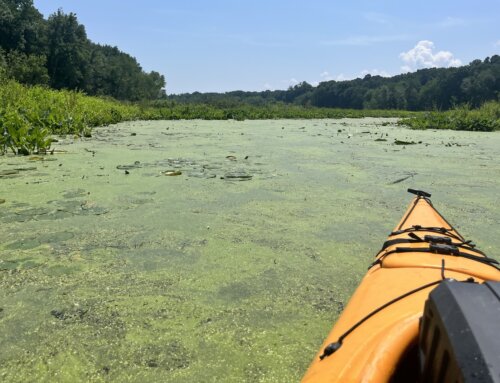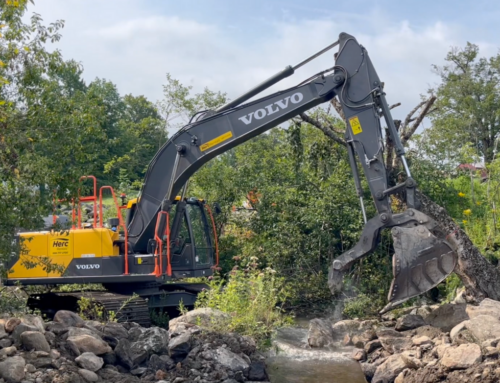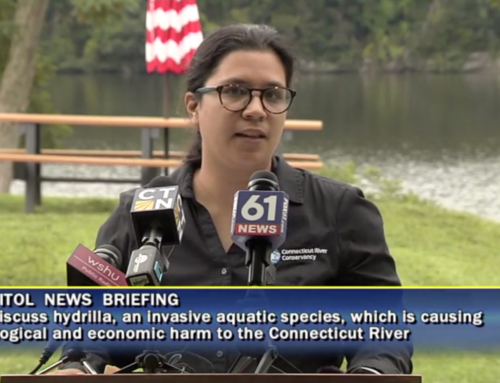The 2015 river season is here and the Connecticut River Watershed Council asks all river users to protect the Connecticut River and its tributaries from invasions of exotic plants and animals. Whether you make use of a powerboat, scull, canoe, kayak, sailboat or if you wade, swim, or fish, as river enthusiasts you have a special responsibility to protect the Connecticut River watershed.
There are no “fixes” once exotics are in our waters. Once established in a new habitat they propagate quickly because they do not face their usual predators. In their uncontrolled explosions, exotics deny native species their usual habitat. They also create problems for humans; just ask anyone living on a lake where Eurasian milfoil has taken hold and choked their lake or ask someone responsible for keeping a water intake pipe open in the presence of zebra mussels.
The Menacing Seven boaters need to watch for are Eurasian milfoil, variable milfoil, water chestnut, phragmites, Chinese mystery snail, rusty crayfish, curly leaf pondweed, and the zebra mussel. OK, it is eight nasty’s but you get the idea.
One example that is a threat right now is water chestnut. A new patch discovered in the mainstem of the Connecticut River in the Hinsdale, NH reach of the river could mean trouble for the whole river. Volunteers have been working for two years to eradicate this new infestation by hand pulling and they will be back at it this year.
Other than plants and animals there is a potential invasion of a virulent infectious virus Viral Hemorrhagic Septicemia, called VHS just some 75 miles to the west of our watershed. VHS has the potential to kill fish by the thousands. The virus incubates in fish for months, so moving baitfish from one water body to another, risks spreading the virus. Heed the restrictions on moving untested uncertified baitfish between water bodies including those bait fish you net yourself.
Beyond the threat of spreading the virus by using uncertified baitfish, there is the possibility you could be introducing an exotic fish species to a new body of water. You should know where your bait came from, what the species is, and whether or not it is native to the body of water where you are going to fish. If you are introducing the wrong species of baitfish into a water body, you are introducing an invasive species of fish and that can have devastating effects on the resident fish population.
It is not hard to protect the river though. Just think: Check, Clean, or Dry!
Check: At the ramp during trailering, thoroughly inspect your boat’s hull, drive unit, trim plates, trolling plates, prop guards, transducers, anchor and anchor rope, and trailer. Inspect all craft, powerboat or canoe, and scrape off and throw out any suspected mussels and all waterweeds hanging from boat or trailer. Do not move live bait from one water body to another. Do not dump live bait into the water; the bait may be a non-native species or diseased.
Clean: Before launching your boat, thoroughly flush the hull, drive unit, live wells, any pumping system, bilge, trailer, bait buckets, engine cooling water system, and other boat parts. Drain all bilge water, live wells; bait buckets and any other water from your boat and equipment at the ramp as you leave a water body. One quick way to clean the exterior is to use a hot hard spray from a do-it-yourself carwash. Hot water pumped through an engine’s intake periodically is one method of preventing zebra mussel growth inside an engine’s cooling system. Do not use chlorine bleach or other environmentally damaging washing solutions in the water or next to the shore. If you are not sure that your water toy is clear of invasives, you should dry it.
Dry: Dry out all items that can absorb or hold water. If you cannot clean your water toys or tools, boats and trailers, PFDs, water shoes and boots, etc. dry them thoroughly in the sun for up to 5 days before using them in another water body.
Care in preventing further spread of infestations of non-native species of plants and animals is the only tool we have at our disposal to protect the Connecticut River watershed. Act as though every waterbody harbors problem species, rely on the precautionary principle, be safe not sorry.
CRC hopes all of those who play on, in, or under the river or its tributaries will be especially careful and protect our rivers from further invasions by exotics. You enjoy it, so do not ruin it for yourself, and remember: Check, Clean, or Dry!
David L. Deen is the River Steward for the Connecticut River Watershed Council. CRC is celebrating over 60 years as a protector of the Connecticut River.







